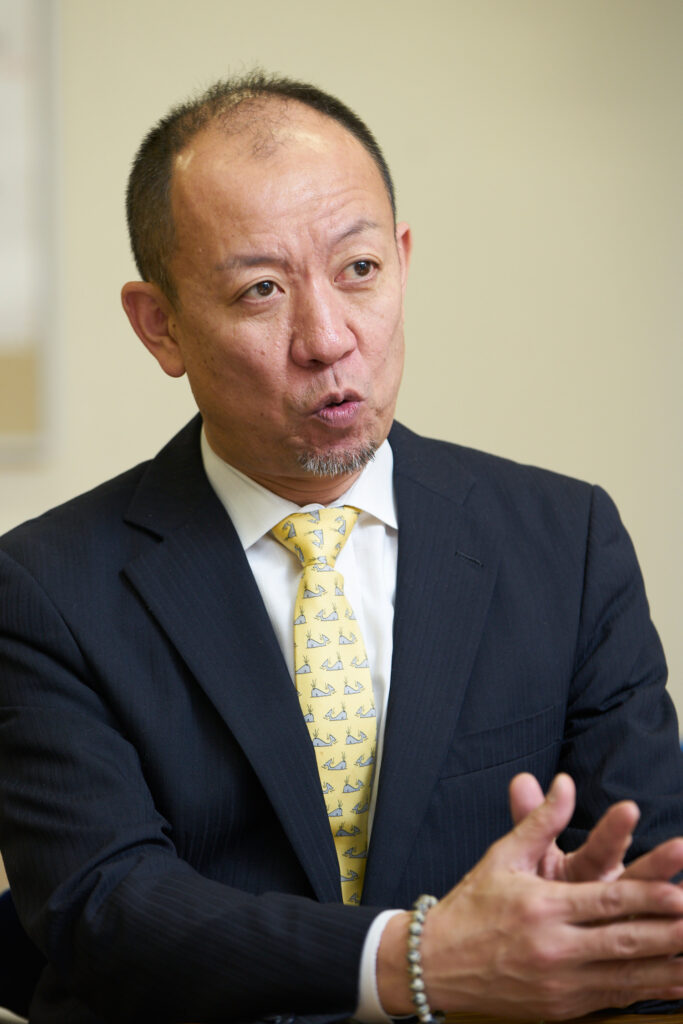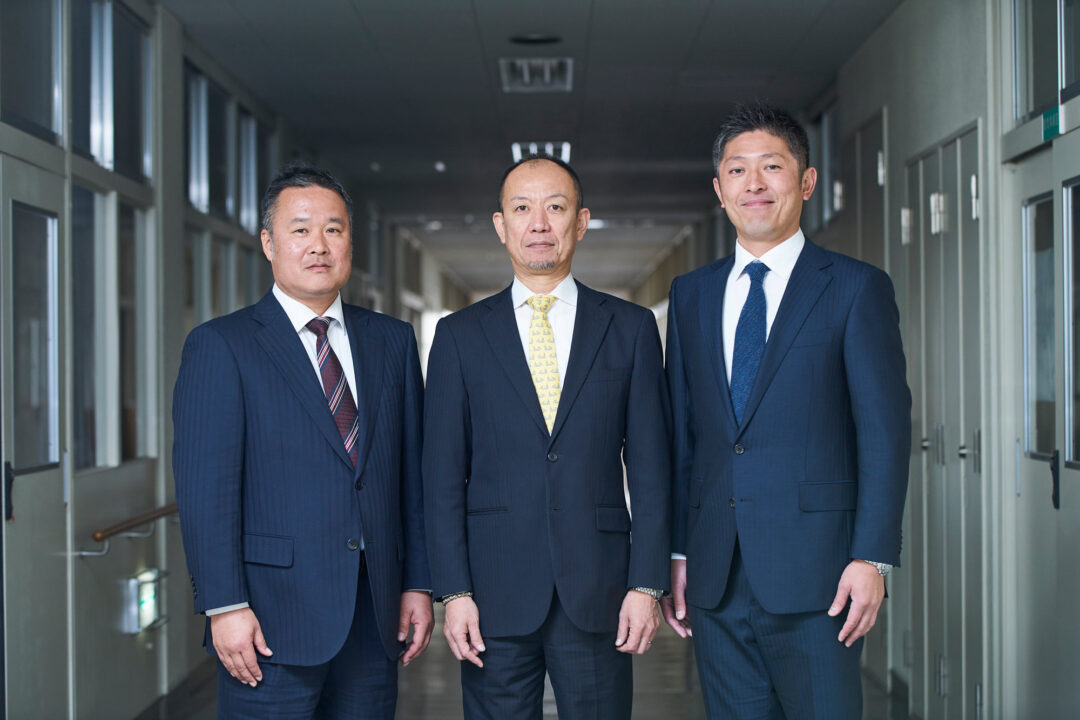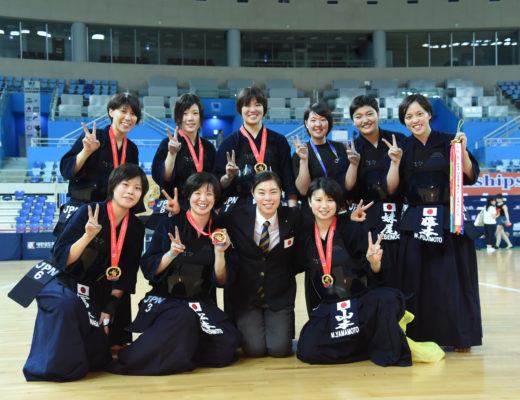2019.3 KENDOJIDAI
Instructors in the field are concerned about how to get students to like Kendo, and how to increase the number of their club members. These instructors from joint Keiko sessions shared their honest opinions with each other.


Born in Tokyo in 1970. After graduating from Tokyo Metropolitan Hachioji Kita High School, he went on to study at the Nippon Sport Science University. After graduation, he became a high school teacher in Tokyo. He is currently a senior teacher at Kokubunji City Third Junior High School and the head of the Kendo Competition Division of the Tokyo Junior High School Sports Federation.

Born in Tokyo in 1976. After graduating from Tokyo Metropolitan Nishi High School and Tsukuba University, he became a teacher in Tokyo. Currently, he is a teacher at Hachioji Higashi High School and the Secretary General of the Kendo Division of the National Federation of High School Associations.
A beginner’s club was established. Experienced people will be cheering them on
– What is the current state of Kendo in junior high and high schools in the Tama area?
Kimura: I was the district leader of the 10th district for several years. At that time, the Koganei Junior High School was active on a national scale in Kendo. So, it was difficult for students who started at junior high school to advance to the top of tournaments. Therefore, we held a district training session for beginners in August, and established a beginners’ division for basic techniques only at the district tournament held in October. In addition, at the same tournament held in March, a Sanbon-shobu Shiai were held in the beginners’ division to give students a chance to play an active role. Students who participated in the regular tournament cheered for the beginners’ division, which created a great atmosphere for the tournament. Now even students who started late, like from junior high school, were able to train and compete on the same ground with experienced students after a year of learning the basics, which stimulated the experienced students as well. Beginner’s tournaments are now held in other districts as well, but especially for girls, the number of beginners tends to be larger than the number of experienced players. There is naturally a difference in strength between students who have been practising Kendo since elementary school and those who started in junior high school, so if we can create a division for beginners at tournaments and give them more opportunities to be in the spotlight, I think it will help them to fall in love with Kendo and increase the retention rate.
Kutsukake: The majority of students at schools that are considered to be powerful have been attending Dojos since elementary school and are members of the Do-ren (All Japan Kendo Dojo Federation). These students continued to study Kendo in elementary school, junior high school, and even senior high school, and their social structure is well established. Therefore, they will not leave Kendo unless they have a good reason to do so, so the important thing is to improve the middle class. I think we have to try various ways to increase the percentage of students who start out with Kendo in junior high and senior high school club activities to continue Kendo. Our school is an industrial high school, and when I first arrived, there were only beginners. Kendo cannot be all fun, so I think it is important to devise ways to keep students interested without deviating from the main idea. There are many students who started Kendo in junior high school who are very talented, and I hope that these students will continue. The Tokyo Metropolitan Federation of High School Associations’ Kendo Division holds seminars twice a year. Students from schools that do not have Kendo instructors are encouraged to participate, and the first step is to pass the 1st Kyu level. Then, we want them to work towards achieving 1st and 2nd Dan.
Ueki: In high school, students have more things to engage in other than just club activities. There are no students who work part-time at our high school, but there are some students who have done Kendo that join clubs that are open to them from high school, such as the dance club or the music club. These have a glamorous image, and even if we don’t have those clubs on campus, some students are involved in musical activities outside of school. It is up to the students to choose their own clubs, but as a Kendo instructor I would like to prevent them from moving away from Kendo somehow.
– I found that the Tama area junior and senior high school exchange Keiko session held today was a great idea to increase the continuation rate in Kendo.

Kutsukake: For the senior high school students, it is an opportunity to see the Sensei who taught them Kendo in junior high school. The training session itself has a history of about 20 years, and this is the 11th year since it was held at the school where I work (Tama Kogyo). Although Tama Kogyo is a public high school, they have a recommendation system for Kendo practitioners to apply for enrolment. This time, 14 high schools and 23 junior high schools participated in the event.
Kimura: For junior high school students, this is a good opportunity to visualize themselves in the near future. As they are divided into groups and instructed by high school students, they can get a concrete understanding of what Kendo will be like when they go to high school. This kind of exchange is a very valuable opportunity for junior high school instructors too.
– What are the most common reasons for students wishing to enter a public high school?
Kimura: There are students who prioritize their study, but there are also students who opt to continue Kendo at a public school with a strong Kendo program. It is a matter of balance with academic achievement, but if they continue Kendo and return to the junior high school as alumni, it will be a great honour for the instructor. However, it is difficult to create such a cycle in public schools because of the teacher transfers.
Ueki: The influence of the coach is great. Even if it’s your alma mater, if the Sensei who taught you is no longer at the school, you probably won’t come back.
Tokyo Metropolitan High School Recommendation System. Securing core personnel
– You mentioned that not only Tama Kogyo but also other public high schools have a recommendation system for students with Kendo experience.
Kutsukake: Tama Kogyo introduced this system eight years ago. Five clubs, including the Kendo club, have been using the system, but now only the Kendo club and the baseball club are using it. When junior high school students look at the high school website, some of them look at the club activity pages, so we always promote the fact that you can do Kendo at Tama Kogyo by posting detailed information about our Shiai results.
Although there is a Kendo recommendation system, there is no preferential treatment in terms of academic achievement or tuition fee like at private schools. The examination consists of a practical Kendo skill test and an interview. There are times when students with much higher academic ability than our school’s level enrol because they want to continue Kendo at Tama Kogyo.
– The recommendation system of private schools can have the feel of advertisements, but yours seems to be different from that.
Kutsukake: The students who entered through the recommendation system have become the core of our school by making our club activities thrive. The Tama Kogyo Kendo Club has also been revitalized since the introduction of the recommendation system. Students who work hard in clubs also study hard, which is highly valued by teachers of other subjects.
– What are the main reasons why students leave Kendo when they move from junior high school to senior high school?
Ueki: One senior high school teacher asked a new student who had Kendo experience, “You did Kendo in junior high school, so why don’t you do it in high school?” He replied, “I just had enough of it”. This is a case of burnout, or a case where the instructor’s best efforts to teach backfired. On the other hand, there are cases where a student continues Kendo without an instructor, never encountering the great appeal of Kendo, and just ends up leaving Kendo after all.
Kimura: When I ask students who are not sure whether or not to continue Kendo the reason for their doubt, they often say, “I want to try other things”. There are several students doing Kendo in the same grade, but unfortunately some of them leave Kendo.
Kutsukake: There are many reasons for this, and it would be difficult to keep 100% of the graduates going. Some students who were in other clubs in junior high school to join the Kendo club in high school, but it is rare. If there are many seniors and teachers who do Kendo in the environment, the continuation rate should increase. Ideally, it would be nice if students could participate in high school clubs and have a clear goal of how they want to proceed, but students who are unsure about whether or not to continue will need some direction.
Ueki: Among Kendo clubs, there are some which suit you and others do not. To put it another way, a student who wants to balance study and Kendo will feel uncomfortable if their day is filled with club activities of kendo, while a student who wants to practice Kendo a lot will lose motivation if there is only a few Keiko a week.
– It is important for each school to send out good information about the atmosphere of the club activities. Kimura-sensei, how many students in your Kokubunji Junior High School start Kendo as beginners?
Kimura: This year, we have two first-year girls who are both beginners, and one boy who is an experienced player. In the second year, three students are experienced and one is a beginner for both boys and girls. The number of students is small, but we have a few beginners every year. Junior high school students have a high level of understanding, so if they practise hard for a year, they can learn the movements of Kendo without much instruction and improve quickly.
Kutsukake: Even if you start Kendo in junior high school, you can move up another level in high school. It is not too late to start Kendo in junior high school. You see this often for girls, who remain active in high school.
Kimura: We have a student who started kendo in junior high school and went on to a strong high school. I was worried that they would not be able to continue because of the harsh environment, but they were very successful in tournaments. When they started Kendo, they couldn’t even do Sonkyo properly, but they continued to practise Kendo under a strict environment. I think it is possible for students who start Kendo in junior high school to continue Kendo in high schools that aim to become the best in Japan.
Kutsukake: These students may be seeking Kendo on their own, choosing a tough environment with a clear goal. I think they become stronger and stronger because they have a clear aim.
– Do you have any students who start in high school?
Kutsukake: There have been fewer students since the recommendation system started at Tama Kogyo. There was one student who graduated last year who said he wanted to quit after the first year camp, but he managed to continue Kendo until he graduated. There is a tournament called the Tokyo Technical High School Kendo Tournament for technical high schools in Tokyo, and he made it to the third round of the individual competition, and his father, who had come to cheer him on, shed tears. He loves railroads, so after graduation he joined a company that inspects and maintains railroads and he is doing well. He is now away from Kendo, but he comes to our training camps. He was a beginner. He doesn’t have time to practice Kendo at work, but when he comes to the high school Kendo club, he practices with us. These kids are recognized by others because of their enthusiasm and energy. The current students may be better than them in terms of ability, but he is still involved in that way. It may take a lot of courage to start in high school, but I tried to give the students who took the trouble to start confidence. The threshold may be high, but once you get in, you’ll fit right in.
Ueki: At Hachioji Higashi High School and my previous workplace of Hibiya High School, they don’t have a sports recommendation system, but there were students who started Kendo as beginners because they were fascinated by martial arts. Especially in the case of girls, the number of girls who start Kendo as beginners is very small, so they are an important asset. Experienced students are welcome, but inexperienced students need to be nurtured as well, otherwise the number of members will continue to decrease. For girls, if they continue to practice hard during their three years in high school, they can compete well against schools that are strong in tournaments. The overall level of girls is somewhat stagnating, so even if you start in high school, you can still compete well.
Kimura: For girls, the skill level becomes relatively similar regardless of whether they start in high school or not.
Ueki: You need a certain number of people to make it lively. There was a school with only a few members who came to today’s Keiko session, and I thought that was really impressive.
Necessity of securing training time and balancing it with studies
– In March 2008, the Sports Agency announced the “Comprehensive Guidelines on Athletic Club Activities”. What impact will this have on the field?
The rest of this article is only available for Kendo Jidai International subscribers!





